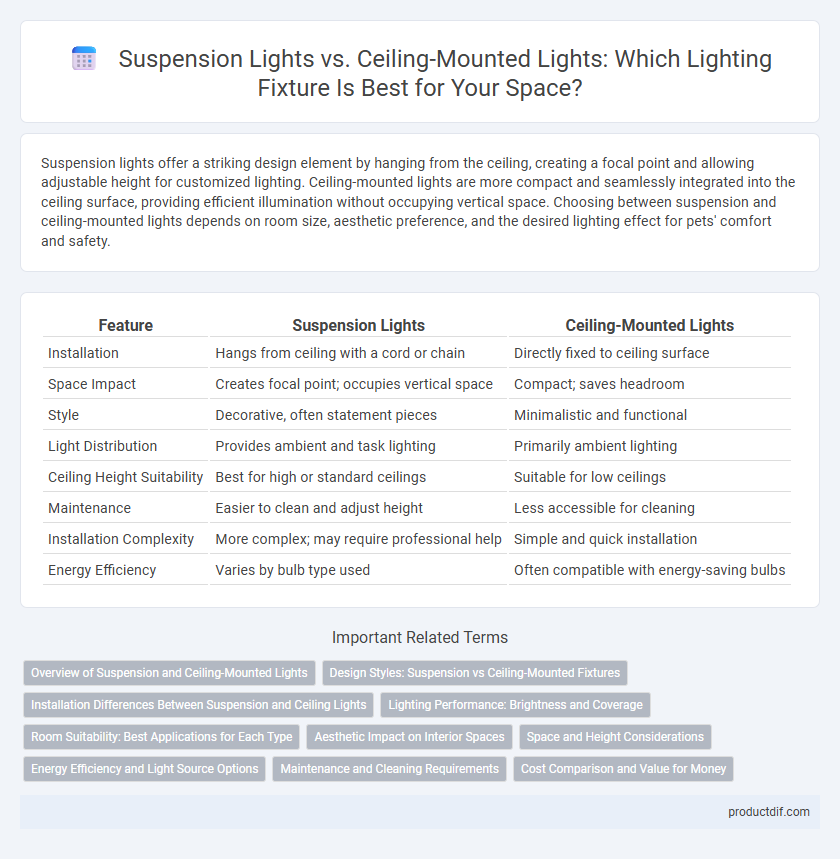Suspension lights offer a striking design element by hanging from the ceiling, creating a focal point and allowing adjustable height for customized lighting. Ceiling-mounted lights are more compact and seamlessly integrated into the ceiling surface, providing efficient illumination without occupying vertical space. Choosing between suspension and ceiling-mounted lights depends on room size, aesthetic preference, and the desired lighting effect for pets' comfort and safety.
Table of Comparison
| Feature | Suspension Lights | Ceiling-Mounted Lights |
|---|---|---|
| Installation | Hangs from ceiling with a cord or chain | Directly fixed to ceiling surface |
| Space Impact | Creates focal point; occupies vertical space | Compact; saves headroom |
| Style | Decorative, often statement pieces | Minimalistic and functional |
| Light Distribution | Provides ambient and task lighting | Primarily ambient lighting |
| Ceiling Height Suitability | Best for high or standard ceilings | Suitable for low ceilings |
| Maintenance | Easier to clean and adjust height | Less accessible for cleaning |
| Installation Complexity | More complex; may require professional help | Simple and quick installation |
| Energy Efficiency | Varies by bulb type used | Often compatible with energy-saving bulbs |
Overview of Suspension and Ceiling-Mounted Lights
Suspension lights hang from the ceiling by cords, chains, or rods, offering adjustable height and a decorative focal point ideal for dining areas or living rooms. Ceiling-mounted lights, such as flush or semi-flush fixtures, are installed directly against the ceiling, providing uniform ambient lighting suitable for rooms with lower ceilings or limited space. Both types differ in aesthetic impact and functionality, with suspension lights enhancing visual interest and ceiling-mounted options maximizing headroom and subtle illumination.
Design Styles: Suspension vs Ceiling-Mounted Fixtures
Suspension lights often feature contemporary or industrial design styles that create focal points in a room through bold shapes and adjustable heights. Ceiling-mounted fixtures typically embrace minimalistic or traditional aesthetics, offering flush or semi-flush profiles that blend seamlessly with the ceiling surface for a streamlined look. Choosing between suspension and ceiling-mounted lighting depends on the desired visual impact, spatial dynamics, and overall interior design theme.
Installation Differences Between Suspension and Ceiling Lights
Suspension lights require secure anchor points and often involve hanging hardware, making installation more complex and time-consuming compared to ceiling-mounted lights, which are typically flush against the ceiling surface. Ceiling-mounted lights generally use direct wiring with mounting plates or brackets, allowing for a straightforward and quicker installation process. The choice between suspension and ceiling lights influences not only aesthetic but also installation effort, with suspension types necessitating precise height adjustments and support considerations.
Lighting Performance: Brightness and Coverage
Suspension lights offer focused illumination with adjustable height, providing targeted brightness ideal for task lighting and creating ambient zones. Ceiling-mounted lights deliver broader coverage with evenly distributed brightness, enhancing general illumination across larger areas. Choosing between them depends on balancing the need for concentrated light versus wide, uniform brightness in a space.
Room Suitability: Best Applications for Each Type
Suspension lights are ideal for rooms with high ceilings or open spaces like dining areas and kitchens, where they provide focused illumination and act as decorative focal points. Ceiling-mounted lights suit low-ceiling rooms such as bedrooms, hallways, and bathrooms, offering evenly distributed ambient lighting without occupying visual space. Choosing the right fixture depends on room height, function, and desired lighting effects to enhance both practicality and aesthetic appeal.
Aesthetic Impact on Interior Spaces
Suspension lights create a striking focal point and add depth to interior spaces by hanging at varying heights, enhancing room dimension and visual interest. Ceiling-mounted lights offer a sleek, unobtrusive look that maintains clean lines and evenly distributes light, ideal for minimalist and modern designs. The choice between suspension and ceiling-mounted fixtures significantly influences the ambiance, spatial perception, and style cohesion within residential or commercial interiors.
Space and Height Considerations
Suspension lights offer adjustable drop lengths, making them ideal for high ceilings and spacious areas where focused illumination or decorative impact is needed. Ceiling-mounted lights are better suited for rooms with lower ceilings or limited space, providing a flush, unobtrusive lighting solution that maximizes headroom and maintains open sightlines. Selecting between these fixtures depends on ceiling height, room size, and the desired ambiance or visual focal point in the space.
Energy Efficiency and Light Source Options
Suspension lights often accommodate a wide range of energy-efficient LED bulbs, offering adjustable brightness and color temperature to optimize energy use. Ceiling-mounted lights typically provide more uniform room illumination with integrated LED modules that consume less power and last longer. Both types support advanced light sources like smart LEDs, but suspension lights offer greater flexibility in directing light, potentially reducing wasted energy.
Maintenance and Cleaning Requirements
Suspension lights typically require more frequent dusting and careful cleaning due to their exposed cables and hanging structure, which can accumulate dust and cobwebs. Ceiling-mounted lights are generally easier to maintain as they are flush with the ceiling, reducing dust buildup and simplifying access for bulb replacement or cleaning. Regular maintenance of suspension lights involves not only cleaning the fixture but also inspecting the mounting hardware for stability, while ceiling-mounted options offer a more streamlined upkeep process.
Cost Comparison and Value for Money
Suspension lights typically cost more upfront due to their intricate designs and installation requirements compared to ceiling-mounted lights, which are generally more affordable and easier to install. When evaluating value for money, suspension lights offer enhanced aesthetic appeal and can serve as statement pieces, potentially increasing a room's visual impact and home value. Ceiling-mounted lights, while more cost-effective, provide functional illumination and versatility, making them ideal for budget-conscious buyers seeking practical lighting solutions.
Suspension lights vs Ceiling-mounted lights Infographic

 productdif.com
productdif.com